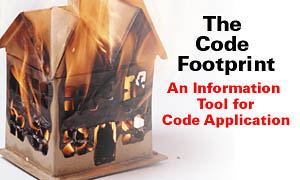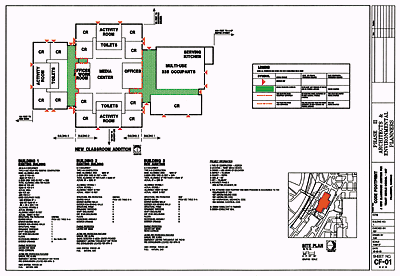
Users of codes that deal with fire protection and life safety features of buildings need an efficient way to communicate code issues with others. Architects, engineers, the Authority Having Jurisdiction (AHJ), plan reviewers, facility owners/operators, facility maintenance personnel, inspection personnel and fire responders are among those who must have efficient, concise and accurate facility information. The "code footprint" can be useful to everyone involved in facility fire protection and life safety and can be an efficient way to communicate, evaluate and maintain valuable code information for the life span of a facility.
The code footprint concept was implemented by staff in a state fire marshal's office to help streamline the plans review process and ensure code compliance. Increasing work loads and decreasing resources forced a look at new ways of doing business, and the code footprint concept has successfully helped present code information in a more user friendly format.
The Problems
Significant problems in the code application and enforcement process can be addressed by using the code footprint concept, including:
- Code requirements that aren't appropriately included in initial design. Building designers have many issues to balance: cost, schedule, weather, site restrictions, design parameters, customer demands, accessibility features and so on. Issues such as these compete with fire protection and life safety issues for the designer's attention. Some designers simply haven't kept up with current code requirements. Regardless of the cause, experience shows that critical code-required fire protection/life safety features are sometimes left out or inappropriately applied during initial design.
- Fire protection/life safety features "buried" in construction documents. Because, full construction documents for even relatively small projects can be quite voluminous, it may take a great deal of time to simply find critical code features, and using the full construction documents can be awkward. Often, small but vital safety features can get "lost" in the mass of information, and the cost of a full set of construction documents can be significant, perhaps limiting the number of copies available. The full construction document set is a bulky container for storing and transporting the diluted form of the specialized information found in the code footprint, and it is especially impractical for use by fire inspection and response personnel. Also, it becomes less useful as the age of the facility increases, largely due to not being updated to reflect the changes a facility typically undergoes over its life span.
- Fire protection and life safety features that are a mystery in existing facilities. Fire protection features such as fire wall assemblies, exiting requirements, area and occupancy separation requirements, and other code features may be difficult to assess without supporting documentation. Determining exactly which walls are required fire assemblies, the location of required exits, the original occupancy and so on is very difficult in some existing facilities without some sort of clear documentation. Fire service inspection personnel, state inspectors and fire response personnel have limited time to spend digging through outdated and cumbersome original construction documents, if they are even available.
- Facility personnel that are unaware of the protective features they should protect and maintain. When a new facility is turned over to the owner/operator, the fire protection and life safety features become their responsibility. Some features, such as automatic suppression systems and fire alarm signaling systems, are rather obvious and the need to maintain them potentially easy to understand. The more subtle passive systems, including fire barrier assemblies, corridor protection and stair enclosures, may not be recognized by the owner/operator as a functional part of the fire protection and life safety systems. Efforts to educate the owner/operator are hampered without a concise, easy to use and easy to retrieve source of documentation of the active and passive protection features of his facility. Maintenance personnel don't have a clear idea of the location of passive systems and may inadvertently waste resources by, for example, providing unneeded firestopping for penetrations in ordinary partition walls, thinking they were fire wall assemblies. Another example is a commonly noted occurrence in code enforcement: failure to maintain a required fire separation due to simply not knowing it was there and that it was required to be maintained.
- Lack of a central "rallying point" for fire protection programs. A very diverse group of people is involved in providing and maintaining fire protection and life safety for the large universe of new and existing occupancies. From licensed architects, professional engineers and managers with post-doctoral credentials to the custodial and maintenance staff (and everyone in between), everyone involved in providing safety for their facility's occupants must participate in a coherent program. Without an easy to understand, easy to maintain tool to communicate and store the program's key information, communication among the diverse functions and people is less efficient, and the fire protection and life safety programs are likely to be less effective.
- Dwindling resources and increasing demands. Unfortunately, this applies to nearly everyone in code application and enforcement. It is particularly acute in the public sector, with few exceptions. Most governmental entities are expected to "do more with less." Providing quality service under these conditions means developing more efficient methods for handling information.

A Solution: The Code Footprint
The code footprint (Figure 1) is a unique, small-scale "snap shot" of key code information shown in a schematic, contextual form. It contains only the information pertinent to understanding the fire protection and occupant safety aspects of a facility.A narrative section contains basic building, code and site information. A legend describes the unique symbols used on the code footprint's schematic. The schematic graphically shows the facility and the fire protection and life safety elements in contextual format-as they exist in relation to each other and the total protective features of the building. Significant advantages of the code footprint include flexibility and efficiency.
Here are some solutions to the previously mentioned problems:
- The code footprint helps ensure code compliance in the initial design phase. Developing a code footprint early in the design phase does not require either a great deal of time or expense. The information in a code footprint is the same as that used in the design; no new information is needed. The only additional activity is the production of the code footprint itself. However, producing the code footprint forces design concentration on vital code information with little distraction. Thus, it causes some omissions or mistakes to jump out at you at first glance during a review and some to be caught during the actual code footprint production.
Designers have remarked that although the code footprint seemed unnecessary at first, it became a valuable tool during the dynamic design phase. It functioned as a "self check" mechanism and provided a means to keep track of vital code elements throughout the design process. This has been true for both large and small facilities and with all types of occupancies.
- The code footprint can be thought of as a potential money saver for the designer. It is always less expensive to include fire protection and life safety features in the original design rather than attempting to force fit them in at a later time. It is reasonable to think that the code footprint may often offset its minimum production expense by preventing design changes due to code non-compliance. The code footprint also improves coordination between the designer and his consultants, construction document team and others, including detail designers and drawing system operators.
The code footprint allows quick, universal access to the information it contains because it is relatively "low-tech." However, it is also readily adaptable to sophisticated, high technology use.
- Fire protection/life safety features are easy to see and understand. The code footprint contains only specialized information and presents it in a concise, clear manner. It is usually produced on an 11-in. x 17-in. sheet. Very large facilities may need to be portrayed on a larger sheet, but all pertinent details of many facilities can be clearly seen on a standard 8-1/2-in. x 11-in. sheet. A separate sheet should be used for each floor of multiple story buildings.
- This small, simplified format is ideal for field use. It is convenient to carry and use while walking through a facility. The footprint's clarity also makes it easier to show features to others at the site that may not be experienced at reading drawings.
Discussions concerning the code aspects of the facility are enhanced and tend to be more efficient when all parties are referring to a code footprint. It helps clarify the location and nature of features that have been concealed, such as fire barrier assemblies above suspended ceilings.
- Fire protection and life safety features in existing facilities are clearly depicted. The minute a new building is turned over to the owner, it becomes an existing facility. From that moment on, the building's code compliance aspects become history. Anyone who has walked into an older facility with which they were not familiar knows the difficulty of making a cognizant assessment of its code compliance status. Sometimes it is impossible to even determine which codes were originally in use.
A code footprint can be produced for an existing facility when required and serve as the baseline document for code compliance. Inspection and assessment personnel can then have a clear guide to use to determine features such as separations, protected corridors, assembly ratings, required exits, etc. Code enforcement consistency is immediately enhanced with the use of the documentation in a code footprint.
- Non-compliant aspects and compensatory measures of the facility can be documented on a code footprint. On the code footprint, the compensatory mitigation measures can be easily related to the non-compliant features, reducing confusion when facility or inspection personnel change.
- The code footprint can help facilities maintain fire protection and life safety features. Maintaining the fire protection and life safety features in a building is just one of the owner/operator's concerns. Changes in maintenance and management personnel may mean important information about the building is lost. The code footprint can be used to maintain the key information about the building's vital protective features. The small and concise format makes it easy for the facility personnel to keep the footprint available in the owner/operator's desk drawer, on the wall in the maintenance shop or wherever else it is useful. The code footprint will quickly and easily answer the question, "Is this wall a fire wall?" Building personnel can use the footprint to keep track of contractor activities and head off problems with unauthorized changes to fire protection features. Facility changes can be documented on the footprint, keeping it up to date and useful for the facility's life span.
- It provides a central "rallying point" for the facility's fire protection and life safety programs. To people who are not fire protection/life safety professionals, many fire protection and life safety concepts are not common sense; rather they can be somewhat nebulous and difficult to grasp. Without education and training, many code requirements simply don't easily lend themselves to intuitive thought. Therefore, the building personnel responsible for the fire protection programs can greatly benefit from using the code footprint as the central focus for the programs. The footprint's clarity and focus on specialized information can help the facility personnel more readily grasp these concepts.
And, it can also be used to communicate important points to others involved in the program. It can be used as a focal point for fire protection/code personnel to communicate with the facility owner/operator. Since the code footprint shows the facility's protective features in context with the use and function of the building and occupants, it is an excellent tool for the code professional to use to educate facility personnel.
- It maximizes resources. This aspect may be the most significant to those involved in code application and enforcement. Some AHJs have had to reduce their level of review due to budget restrictions and an increasing workload. The code footprint allows them to more easily focus on the important code issues. Its format saves time by eliminating the need to wade through construction documents and by reducing review errors by presenting the information in a concise, contextual and simplified format.
The AHJ can customize the code footprint's contents by requiring the designer to include details to satisfy their specific local requirements and needs. Implementation of the code footprint concept by an AHJ may be as simple as developing a policy of what will be accepted for review. The code footprint should bear the licensed designer's seal, according to applicable requirements. It should also be included as a part of the full construction document package.
- AHJs that perform on-site inspections, but haven't placed an emphasis on plan review, can use the code footprint to help bridge the gap between plan review and on-site inspections. The code footprint's clarity and conciseness makes it easier to implement a plan review program with personnel without heavy plan review experience.
- Inspections and assessments can be performed faster and more effectively with the code footprint in hand. The code footprint shows the location of vital protective features clearly and graphically. As a communication tool, it makes the job of explaining assessment findings to the owner/operator much easier.
- Fire response personnel are also facing higher service expectations without budget increases. The footprint is ideal for pre-incident planning and can provide valuable information during an incident. The footprint can give responders detailed information on potential events during a fire incident.
The locations of fire barriers can indicate likely locations of tactical perimeters. The types and locations of protected egress routes on the code footprint can indicate the best and safest potential rescue routes. It can be a valuable tool for communication with the facility personnel during pre-incident planning.
A Tool of Many Uses
The code footprint can be a very useful tool for those whose goal is to provide facility fire protection and occupant life safety in all types of facilities. It is a concise, efficient, easy to understand information tool to use to communicate fire protection and life safety issues to the diverse group of people involved in code application and enforcement. And, unlike most code enforcement tools, it can also be very useful to facility owners/operators.The code footprint concept is flexible enough to serve specific local needs. Perhaps it is the only type of document that portrays the facility in a holistic code perspective-it provides an overview of the entire facility instead of merely showing individual pieces of code application. It may also be unique because it is intended to remain useful for the facility's entire life span, documenting changes and modifications as they occur over time.
Some of the potential advantages of the code footprint are:
- It can be used to verify fire protection/life safety features in a short time.
- It is easy and cheap to produce.
- It can be used in lieu of full construction documents for code review.
- It serves as a rallying point for code enforcers, designers and owner/ operators.
- It shows the entire building in one view.
- It shows exits, construction features and active and passive systems, regardless of which code is used.
- It can be used by fire response organizations as the core of a pre-incident plan.
- It can remain useful to fire responders and the owner/operator throughout the building's life span, and
- It is useful when implemented during any stage of a building's life span.
The code footprint is a unique, multipurpose tool with the capability to assist designers, code enforcers and reviewers, facility owners/operators and fire response personnel in the task of providing efficient, effective fire protection and life safety programs in all types of occupancies.
